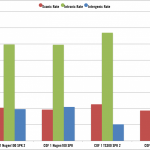Exosomes are a type of membranous vesicle derived from cells and released into the extracellular space. They are generally 30-100 nm in diameter, containing nucleic acid and protein, and can serve as transporters of these materials from cell to cell. Exosomes are released by all cultured cell types and have also been found in biofluids such as blood, saliva, urine and breast milk. In 2007, Jan Lotvall’s group was the first to show the presence of mRNA and miRNA in exosomes.[1] They were able to demonstrate that not only was this RNA delivered from one cell to another via exosomes but also that the mRNA was translated into protein in recipient cells. Since then, exosomes have been shown to contain several categories of non-coding RNAs and form a subset of all extracellular RNA (exRNAs) released by cells.
The role of exRNAs is still a little unclear, but several studies point to increasing clinical relevancy. Stem cells can use exRNAs to kill cancer cells by delivering anti tumor miRNAs.[2] Another study found that tumor cells can release exRNAs and proteins that promote tumor growth.[3] Prions and viruses can also be spread from one cell to another via exosomes. [4-6] As a result, funding for exosome projects has been increasing. Last year, the NIH announced $17M in funding for Extracellular RNA Communication through the Common Fund. With the uptick in funding and the potential clinical utility as biomarkers and therapeutics, there is a lot of development going on in the exRNA realm.

KEITH KASNOT – From The Scientist
As with any field in its infancy, the development of the right tools is critical to further our understanding of extracellular RNAs.
RNA-seq is the obvious choice when studying exosomal RNAs and other exRNAs because of its ability to discover novel transcripts and splice variants. However, there are several considerations in planning an exosomal RNA-seq experiment. Here’s a quick list of things to keep in mind before planning your exosome RNA-seq experiment:
Choosing the best method for your RNA extractions – Historically exosome extractions have relied on ultracentrifugation and sucrose gradient methods. These isolation methods tend to be extremely tedious and low throughput. Recent advances in exosomal (and other microvesicle) kits have made isolations much more efficient. By exploiting properties such as vesicle size or surface markers, these commercial kits are able to do a one step exosome isolation and RNA extraction. Some offer protein and nucleic acid extraction routes at the same time for parallel RNA-seq and mass spectrometry studies.
Sequencing library preparation – Exosomes have been shown to contain mRNAs, small RNAs and other non-coding RNAs. Since one sequencing library preparation doesn’t quite capture the complexity of all the RNA species in there, it is important to use a method that allows you to survey your RNA of interest. Small RNA library preparations can capture miRNAs, siRNAs and piRNAs. More conventional RNA-seq library preps can capture larger transcripts but may have to be modified to deal with more fragmented mRNA or the lack of a poly-A tail. Ribosomal RNA has been shown to be present in exosomes and if sequencing those RNAs is not of interest, appropriate depletion methods will have to be employed. Lastly, since many exosome studies are done using biofluids and clinical samples, RNA amounts are almost always limiting and any sequencing library prep must be optimized for sequencing low input RNA.
Data Analysis – Every successful data analysis approach relies on the availability of a good reference database. Since the field is still in its infancy, there isn’t a huge library of data out there to use as a reference resource but it is growing everyday. ExoCarta [7-9] is one such database that compiles protein, RNA and lipid data from exosome studies. Vesiclepedia is another broader collection of data for all extracellular vesicles, not just exosomes. As part of the exRNA common fund initiative, an ExRNA Research Portal has also been established to catalog all research done as a result of this funding as well as other exRNA related resources of use to the community. Much of the RNA data available is focused on transcript identification and as more sequencing studies are done, there will be more information about relative expression of those RNA species.
While it’s a new field, and there are still a number of techniques and methods to refine, groundwork that has been laid for successful experiments. At Cofactor, we’re developing our exRNA protocols while maintaining our high level of quality control. If you’re interested in starting an exosome project, get in touch.
References:
[1] H. Valadi et al., “Exosome-mediated transfer of mRNAs and microRNAs is a novel mechanism of genetic exchange between cells,” Nat Cell Biol, 9:654-59, 2007. [2] Human liver stem cell-derived microvesicles inhibit hepatoma growth in SCID mice by delivering antitumor microRNAs. Fonsato V, Collino F, Herrera MB, Cavallari C, Deregibus MC, Cisterna B, Bruno S, Romagnoli R, Salizzoni M, Tetta C, Camussi G. Stem Cells. 2012 Sep;30(9):1985-98 [3] Glioblastoma microvesicles transport RNA and proteins that promote tumour growth and provide diagnostic biomarkers. Skog J, Würdinger T, van Rijn S, Meijer DH, Gainche L, Sena-Esteves M, Curry WT Jr, Carter BS, Krichevsky AM, Breakefield XO. Nat Cell Biol. 2008 Dec;10(12):1470-6. [4] Small RNA deep sequencing reveals a distinct miRNA signature released in exosomes from prion-infected neuronal cells. Bellingham SA1, Coleman BM, Hill AF. Nucleic Acids Res. 2012 Nov;40(21):10937-49 [5] Functional delivery of viral miRNAs via exosomes.Pegtel DM1, Cosmopoulos K, Thorley-Lawson DA, van Eijndhoven MA, Hopmans ES, Lindenberg JL, de Gruijl TD, Würdinger T, Middeldorp JM. Proc Natl Acad Sci U S A. 2010 Apr 6;107(14):6328-33 [6] Retrovirus infection strongly enhances scrapie infectivity release in cell culture. Leblanc P1, Alais S, Porto-Carreiro I, Lehmann S, Grassi J, Raposo G, Darlix JL. EMBO J. 2006 Jun 21;25(12):2674-85. [7] ExoCarta as a resource for exosomal research. Simpson, R.J., Kalra, H. and Mathivanan, S. Journal of Extracellular Vesicles. 2012 Apr 1: 18374 [8] ExoCarta 2012: database of exosomal proteins, RNA and lipids. Mathivanan, S. Fahner, C.J., Reid, G.E., and Simpson, R.J. Nucleic Acids Research. 2012 Jan; 40(Database issue):D1241-4 [9] ExoCarta: A compendium of exosomal proteins and RNA. Mathivanan, S. and Simpson, R.J. Proteomics. 2009. 21, 4997-5000.




